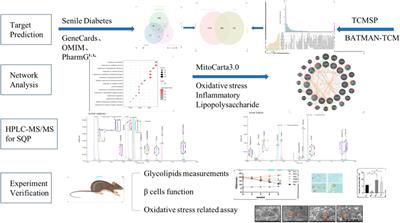Network analysis combined with experimental assessment to explore the therapeutic mechanisms of new shenqi pills formula targeting mitochondria on senile diabetes mellitus

The objective of this study was to investigate the mechanisms of action of SQP in the treatment of SDM and make an experimental assessment.Methods: Network analysis is used to evaluate target pathways related to SQP and SDM. Mitochondrial-related genes were obtained and intersected with the common target genes of the disease and drugs, then constructing a PPI network. Representative compounds in the SQP were quantitatively measured using HPLC-MS/MS to ensure quality control and quantitative analysis of the compounds. A type 2 diabetes micemodel was used to investigate the pharmacodynamics of SQP.
The glucose lowering efficacy of SQP was assessed through various metrics including body weight and FBG. To elucidate the modulatory effects of SQP on pancreatic beta cell function, we measured OGTT, insulin histochemical staining and tunel apoptosis detection, then assessed the PI3K/Akt/ GSK-3β pathway in diabetic mice via western blotting. Additionally, we observe the structural changes of the nucleus, cytoplasmic granules and mitochondria of pancreatic islet β cells.In this investigation, we identified a total of 1876 genes associated with senile diabetes, 278 targets of SQP, and 166 overlapping target genes, primarily enriched in pathways pertinent to oxidative stress response, peptide response, and oxygen level modulation. Moreover, an intersection analysis involving 1136 human mitochondrial genes and comorbidity targets yielded 15 mitochondria-related therapeutic targets. Quality control assessments and quantitative analyses of SQP revealed the predominant presence of five compounds with elevated concentrations: Catalpol, Cinnamon Aldehyde, Rehmanthin D, Trigonelline, and Paeonol Phenol. Vivo experiments demonstrated notable findings. Relative to the control group, mice in the model group exhibited significant increases in body weight and fasting blood glucose levels, alongside decreased insulin secretion and heightened islet cell apoptosis. Moreover, β-cells nuclear condensation and mitochondrial cristae disappearance were observed, accompanied by reduced expression levels of p-GSK-3β protein in islet cells. Conversely, treatment groups administered SQP and Rg displayed augmented expressions of the aforementioned protein markers, alongside preserved mitochondrial cristae structure in islet β cells.Our findings suggest that SQP can ameliorate diabetes by reducing islet cell apoptosis and resist oxidative stress.
These insulin-mediated PI3K/AKT/GSK-3β pathway plays an important regulatory role in this process.
Read the full article at the original website
References:
